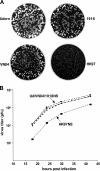The H5N1 influenza virus NS genes selected after 1998 enhance virus replication in mammalian cells
- PMID: 17522219
- PMCID: PMC1951328
- DOI: 10.1128/JVI.00006-07
The H5N1 influenza virus NS genes selected after 1998 enhance virus replication in mammalian cells
Abstract
The NS1A proteins of human influenza A viruses bind CPSF30, a cellular factor required for the processing of cellular pre-mRNAs, thereby inhibiting the production of all cellular mRNAs, including beta interferon mRNA. Here we show that the NS1A protein of the pathogenic H5N1 influenza A/Hong Kong/483/97 (HK97) virus isolated from humans has an intrinsic defect in CPSF30 binding. It does not bind CPSF30 in vitro and causes high beta interferon mRNA production and reduced virus replication in MDCK cells when expressed in a recombinant virus in which the other viral proteins are encoded by influenza A/Udorn/72. We traced this defect to the identities of amino acids 103 and 106 in the HK97 NS1A protein, which differ from the consensus amino acids, F and M, respectively, found in the NS1A proteins of almost all human influenza A virus strains. X-ray crystallography has shown that F103 and M106, which are not part of the CPSF30 binding pocket of the NS1A protein, stabilize the NS1A-CPSF30 complex. In contrast to the HK97 NS1A protein, the NS1A proteins of H5N1 viruses isolated from humans after 1998 contain F103 and M106 and hence bind CPSF30 in vitro and do not attenuate virus replication. The HK97 NS1A protein is less attenuating when expressed in a virus that also encodes the other internal HK97 proteins and under these conditions binds to CPSF30 to a substantial extent in vivo. Consequently, these internal HK97 proteins largely compensate for the absence of F103 and M106, presumably by stabilizing the NS1A-CPSF30 complex.
Figures








References
-
- Basler, C. F., A. H. Reid, J. K. Dybing, T. A. Janczewski, T. G. Fanning, H. Zheng, M. Salvatore, M. L. Perdue, D. E. Swayne, A. Garcia-Sastre, P. Palese, and J. K. Taubenberger. 2001. Sequence of the 1918 pandemic influenza virus nonstructural gene (NS) segment and characterization of recombinant viruses bearing the 1918 NS genes. Proc. Natl. Acad. Sci. USA 98:2746-2751. - PMC - PubMed
-
- Chien, C. Y., Y. Xu, R. Xiao, J. M. Aramini, P. V. Sahasrabudhe, R. M. Krug, and G. T. Montelione. 2004. Biophysical characterization of the complex between double-stranded RNA and the N-terminal domain of the NS1 protein from influenza A virus: evidence for a novel RNA-binding mode. Biochemistry 43:1950-1962. - PubMed
-
- Crescenzo-Chaigne, B., S. van der Werf, and N. Naffakh. 2002. Differential effect of nucleotide substitutions in the 3′ arm of the influenza A virus vRNA promoter on transcription/replication by avian and human polymerase complexes is related to the nature of PB2 amino acid 627. Virology 303:240-252. - PubMed
Publication types
MeSH terms
Substances
Grants and funding
LinkOut - more resources
Full Text Sources
Medical
Miscellaneous

